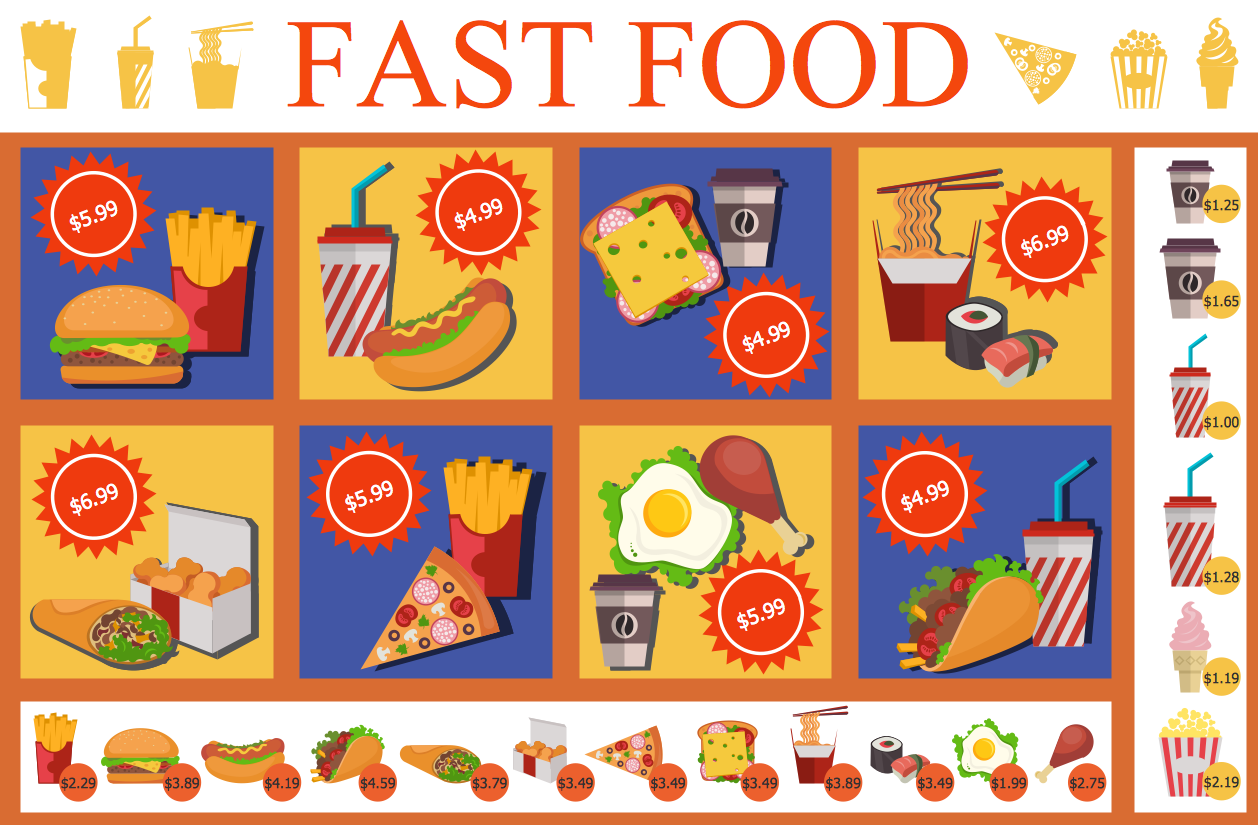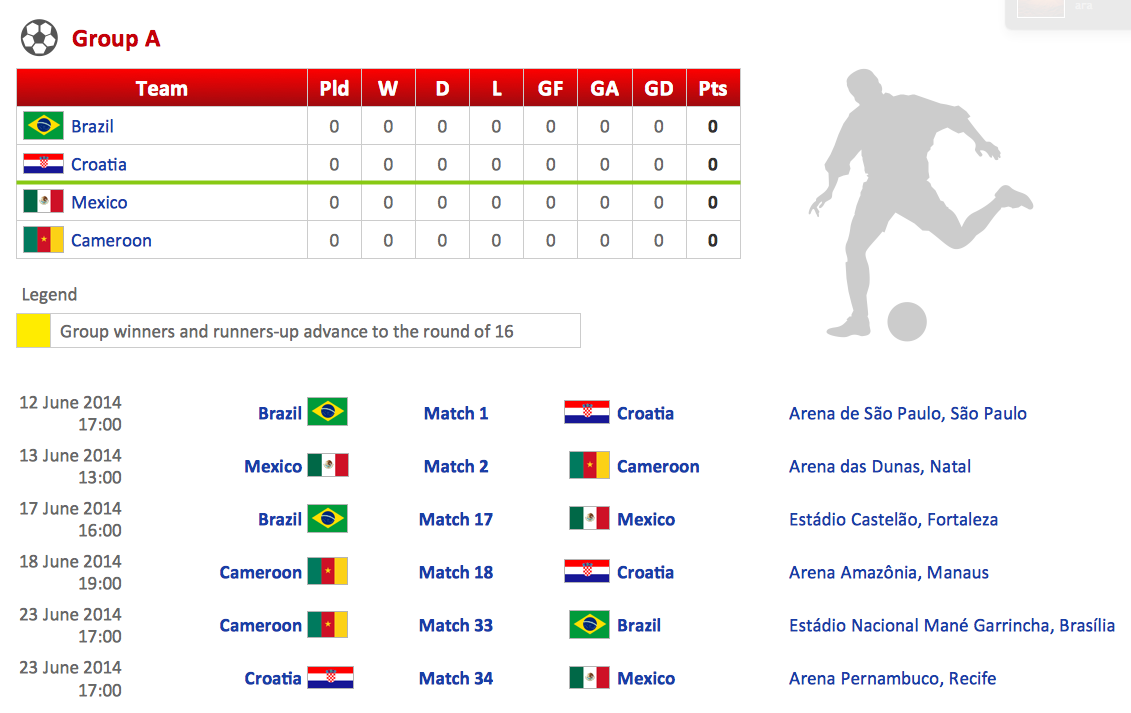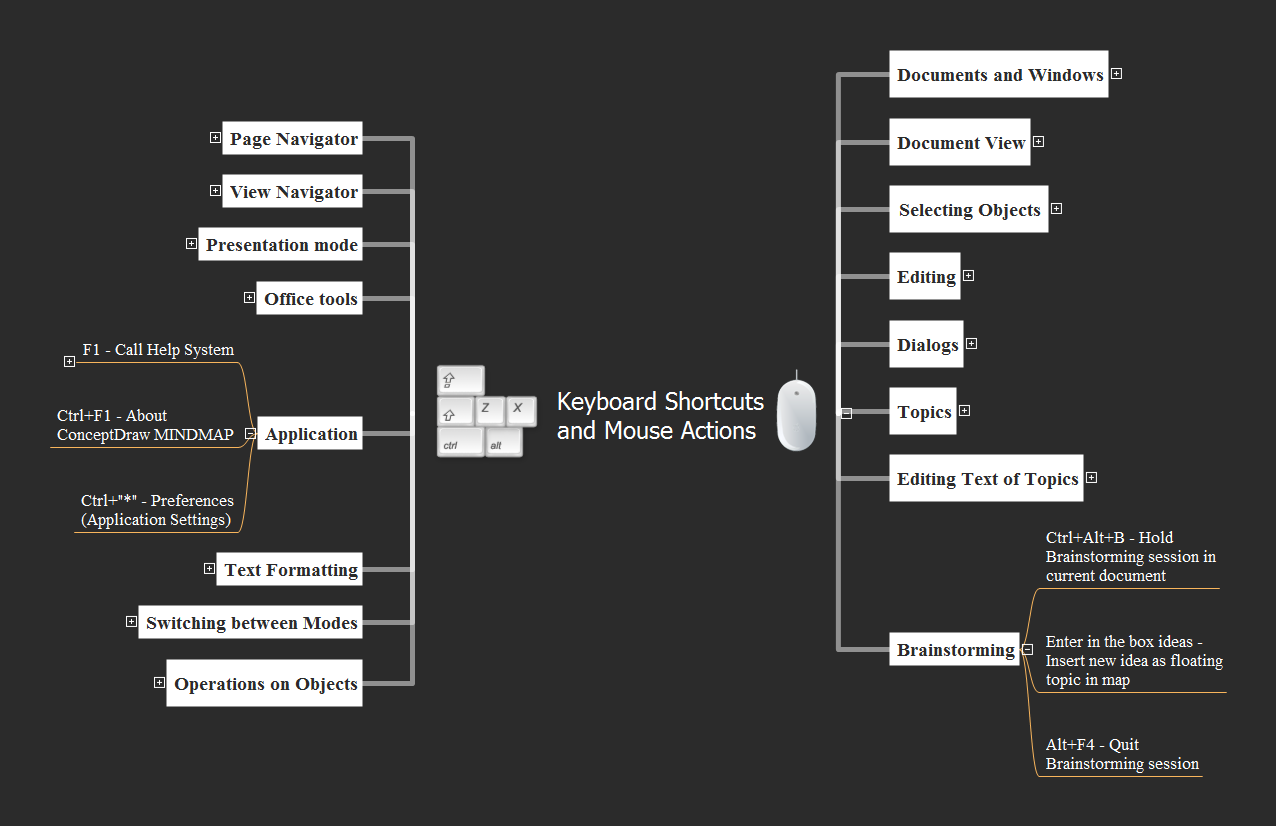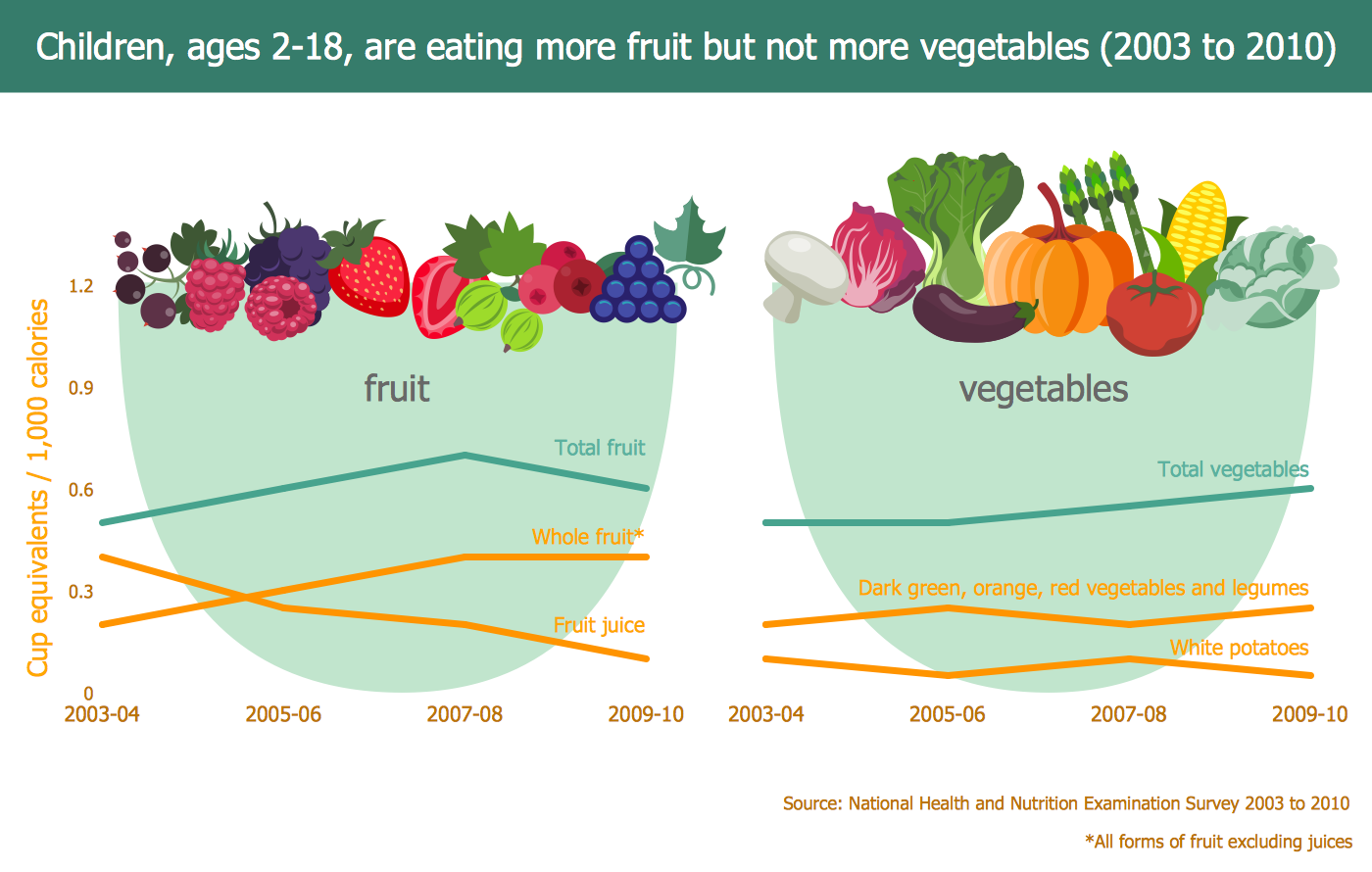F&B
High competition among the restaurants at the food court requires original design ideas. To attract visitors and increase sales are used many kinds of advertising products, brightly colored signboards, menus and show-cases, often are used the molds of beautifully decorated dishes. Now designing of colorful F&B (food and beverage) materials is easier than ever thanks to the ConceptDraw PRO diagramming and vector drawing software extended with Food Court Solution from the Food and Beverage Area of ConceptDraw Solution Park.This bubble diagram sample shows the websites interlinking to illustrate PageRank concept. It was redesigned from the Wikimedia Commons file: Websites interlinking to illustrate PageRank.png.
"Suppose each circle is a website, and an arrow is a link from one website to another, such that a user can click on a link within, say, website F to go to website B, but not vice versa. Google crawlers examine which websites link to each other and assume that websites with more incoming links are what users want."
[commons.wikimedia.org/ wiki/ File:Websites_ interlinking_ to_ illustrate_ PageRank.png]
This file is made available under the Creative Commons CC0 1.0 Universal Public Domain Dedication. [creativecommons.org/ publicdomain/ zero/ 1.0/ deed.en]
"PageRank is an algorithm used by Google Search to rank websites in their search engine results. PageRank was named after Larry Page, one of the founders of Google. PageRank is a way of measuring the importance of website pages. ...
It is not the only algorithm used by Google to order search engine results, but it is the first algorithm that was used by the company, and it is the best-known. Google uses an automated web spider called Googlebot to actually count links and gather other information on web pages." [PageRank. Wikipedia]
The bubble diagram example "PageRank" was created using the ConceptDraw PRO diagramming and vector drawing software extended with the Bubble Diagrams solution from the area "What is a Diagram" of ConceptDraw Solution Park.
"Suppose each circle is a website, and an arrow is a link from one website to another, such that a user can click on a link within, say, website F to go to website B, but not vice versa. Google crawlers examine which websites link to each other and assume that websites with more incoming links are what users want."
[commons.wikimedia.org/ wiki/ File:Websites_ interlinking_ to_ illustrate_ PageRank.png]
This file is made available under the Creative Commons CC0 1.0 Universal Public Domain Dedication. [creativecommons.org/ publicdomain/ zero/ 1.0/ deed.en]
"PageRank is an algorithm used by Google Search to rank websites in their search engine results. PageRank was named after Larry Page, one of the founders of Google. PageRank is a way of measuring the importance of website pages. ...
It is not the only algorithm used by Google to order search engine results, but it is the first algorithm that was used by the company, and it is the best-known. Google uses an automated web spider called Googlebot to actually count links and gather other information on web pages." [PageRank. Wikipedia]
The bubble diagram example "PageRank" was created using the ConceptDraw PRO diagramming and vector drawing software extended with the Bubble Diagrams solution from the area "What is a Diagram" of ConceptDraw Solution Park.
Football – 2014 FIFA World Cup Standings Group
You can see the samples representing the 2014 FIFA World Cup schedules and tournament tables for each of eight groups. These samples was created in ConceptDraw PRO using the “FIFA World Cup 2014 team flags”, “Soccer pictograms” and “Soccer silhouettes” libraries from the Soccer solution from the Sport area of ConceptDraw Solution Park.
 Soccer
Soccer
The Soccer (Football) Solution extends ConceptDraw PRO v9.5 (or later) software with samples, templates, and libraries of vector objects for drawing soccer (football) diagrams, plays schemas, and illustrations. It can be used to make professional looking
Keyboard Shortcuts and Mouse Actions
Mind Maps are an advanced technique used to solve a wide range of professional tasks, personal growth tasks, business tasks, household tasks that occur in everyday life. When you need to make a difficult decision in terms of lack of information, to prepare a report, design a presentation in original way, to organize a brainstorming session, to develop plan for the next week / month / year, to make notes during the lecture, in all these cases the mind mapping technique will be effective. The essence of the method consists in structuring the information, in visualization of objects and concepts, and also in setting the associative relationships. This method is popular in teaching and when explaining new information, and lets represent it in a concise and easily perceived form. Mind Maps can be also effectively used to represent different computer knowledge and helpful information about the use of different applications. ConceptDraw MINDMAP is powerful software for designing different Mind Maps, including the Mind Map demonstrating the keyboard shortcuts and mouse actions that are utilized in ConceptDraw MINDMAP.Food Art
Food courts are very popular places. You want to increase attendance, advertise and invite attention to your food court? Make interesting design and create pictorial and bright food art posters and signboards, and don't forget to decorate your menu with images of tasty treats! ConceptDraw PRO diagramming and vector software supplied with Food Court solution from the Food and Beverage area of ConceptDraw Solution Park offers powerful drawing tools for effective food art.The vector stencils library "Periodic table of chemical elements" contains 119 icon symbols of chemical elements for drawing Mendeleev's periodic table, chemical diagrams, infographics and illustrations.
"A chemical element is a pure chemical substance consisting of a single type of atom distinguished by its atomic number, which is the number of protons in its atomic nucleus. Elements are divided into metals, metalloids, and non-metals. Familiar examples of elements are carbon, nitrogen, oxygen (non-metals), silicon, arsenic (metalloids), aluminium, iron, copper, gold, mercury, and lead (metals).
The lightest chemical elements, including hydrogen, helium and smaller amounts of lithium, beryllium and boron, are thought to have been produced by various cosmic processes during the Big Bang and cosmic-ray spallation. Production of heavier elements, from carbon to the very heaviest elements, proceeded by stellar nucleosynthesis, and these were made available for later solar system and planetary formation by planetary nebulae and supernovae, which blast these elements into space. The high abundance of oxygen, silicon, and iron on Earth reflects their common production in such stars. While most elements are generally stable, a small amount of natural transformation of one element to another also occurs in the decay of radioactive elements as well as other natural nuclear processes." [Chemical element. Wikipedia]
The chemical symbols example "Design elements - Periodic table of chemical elements" was created using the ConceptDraw PRO software extended with the Chemistry solution from the Science and Education area of ConceptDraw Solution Park.
"A chemical element is a pure chemical substance consisting of a single type of atom distinguished by its atomic number, which is the number of protons in its atomic nucleus. Elements are divided into metals, metalloids, and non-metals. Familiar examples of elements are carbon, nitrogen, oxygen (non-metals), silicon, arsenic (metalloids), aluminium, iron, copper, gold, mercury, and lead (metals).
The lightest chemical elements, including hydrogen, helium and smaller amounts of lithium, beryllium and boron, are thought to have been produced by various cosmic processes during the Big Bang and cosmic-ray spallation. Production of heavier elements, from carbon to the very heaviest elements, proceeded by stellar nucleosynthesis, and these were made available for later solar system and planetary formation by planetary nebulae and supernovae, which blast these elements into space. The high abundance of oxygen, silicon, and iron on Earth reflects their common production in such stars. While most elements are generally stable, a small amount of natural transformation of one element to another also occurs in the decay of radioactive elements as well as other natural nuclear processes." [Chemical element. Wikipedia]
The chemical symbols example "Design elements - Periodic table of chemical elements" was created using the ConceptDraw PRO software extended with the Chemistry solution from the Science and Education area of ConceptDraw Solution Park.
- F And B Flow Chat Of Department
- Image Of Organizational Workflow Structure In Food And Beverage ...
- F&B | Websites interlinking to illustrate PageRank | Chemical ...
- Food and Beverage | F&B | Pictures of Vegetables | Clipart Posters ...
- Food and Beverage | Food Art | F&B | Sample Of Pictorial Posters
- McKinsey 7S framework - Bubble diagram | Websites interlinking to ...
- EPC Diagrams Illustrate Business Process Work Flows | Websites ...
- Entity Relationship Diagram Software Engineering | Chemical ...
- Bubble Diagram Wikipedia
- Process F
- Normal distribution graph - Template | Histogram example - Age of ...
- Active Directory diagram - Site links | How to Edit a Project Task List ...
- Workflow diagram - Weather forecast | Workflow Diagram Software ...
- Chemical elements - Vector stencils library | Design elements ...
- Chemical elements - Vector stencils library | Chemical elements ...
- Audio and video connectors - Vector stencils library | Rack diagrams ...
- Football – 2014 FIFA World Cup Standings Group
- Chemical and Process Engineering | Process Flow Diagram ...
- Conceptdraw.com: Mind Map Software, Drawing Tools | Project ...
- Chemical engineering - Vector stencils library | Chemical elements ...




